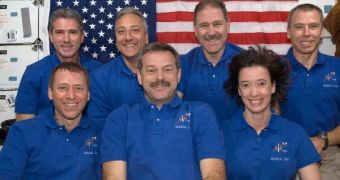Despite the fact that the space shuttle Atlantis had three landing windows and five landing opportunities yesterday, the weather surrounding the Kennedy Space Center (KSC) in Florida, and the Edwards Air Force base, in Southern California, did not cooperate with the astronauts. At the spaceport, severe thunderstorms, which have been affecting the area for days now, made any attempt of flying over the facility impossible. As a result, the crew remained in orbit for yet another day, and will attempt to land today, with a window scheduled for 10:11 am EDT (1411 GMT).
“The weather at KSC has not cooperated with us today. We are waving off for the day,” said the Atlantis crew Mission Control yesterday, after the weather failed to improve enough. “There was just no hope that it was going to get any better,” Space quotes the head of KSC's weather office, John Madura, as saying. Initially scheduled to land on Friday, after a successful 11-day mission to repair the famous Hubble Space Telescope, the shuttle would spend at least 13 days in space, with oxygen supplies estimated to be depleted by Monday. Naturally, by that time, the shuttle has to be on the ground.
If commander Scott Altman does not have the necessary conditions to bring the shuttle down in the first landing window of today, the astronauts will have a second one at 11:40 am EDT (1540 GMT), but this time at the EAFB in California. NASA knows that it's expensive to land the massive orbiter at another location than the KSC, but, at this point, the main priority is getting the crew back safely, after they performed the most complex orbital repair mission ever undertaken.
According to Madura, the weather forecast looks bleak for today as well, but there's a small chance that the storms will clear on Monday. However, waiting until then would mean exposing the astronauts to unnecessary risks. Already, the orbiter makes use of power that would have otherwise fueled back-up systems. Since last Thursday, Mission Control told the STS-125 crew to shut down all non-essential power consumers, in order to conserve as much energy as possible.
During their spacewalks, in which they achieved all of the tasks they had set out to do, and then some, astronauts installed the brand new Wide Field Planetary Camera 3 (WFPC 3) wide-field camera for deep-space observations and repaired the damaged Space Telescope Imaging Spectrograph (STIS), which is able to detect faint light from quasars and black holes. They also installed the new Cosmic Origins Spectrograph (COS), and repaired Hubble's main “eyes,” the Advanced Camera for Surveys (ACS). In addition to bringing its observation abilities back online, Atlantis mission specialists also installed six new gyroscopes, six battery sets, a new Fine Guidance Sensor, as well as a new coating of thermal insulators.

 14 DAY TRIAL //
14 DAY TRIAL //